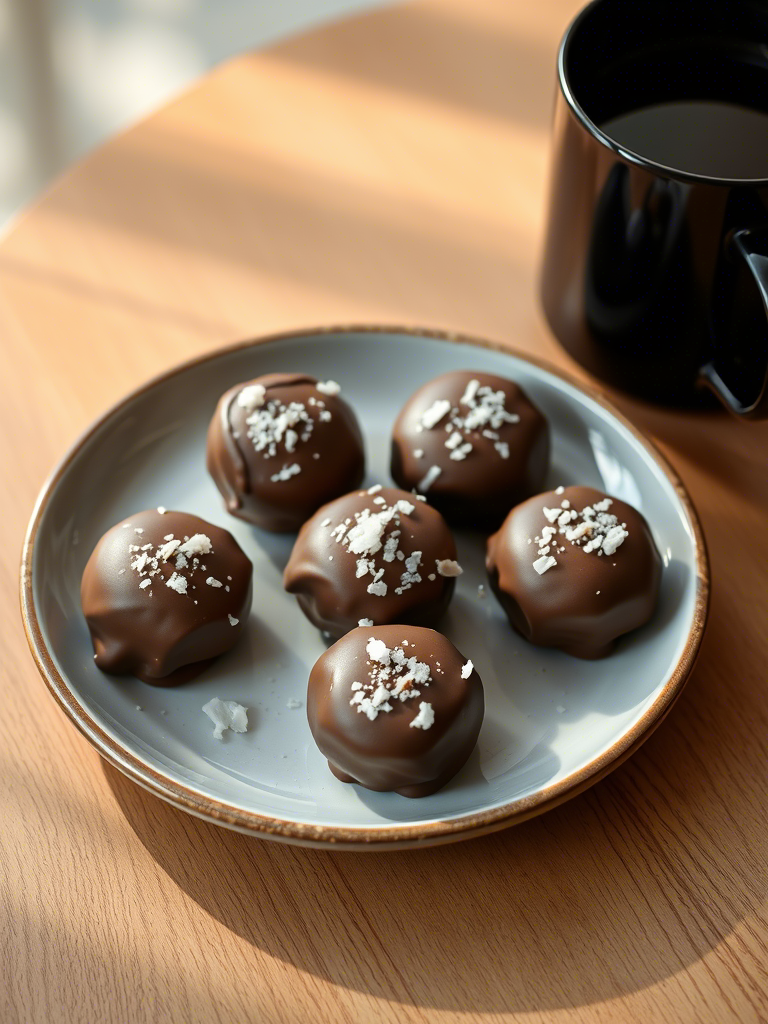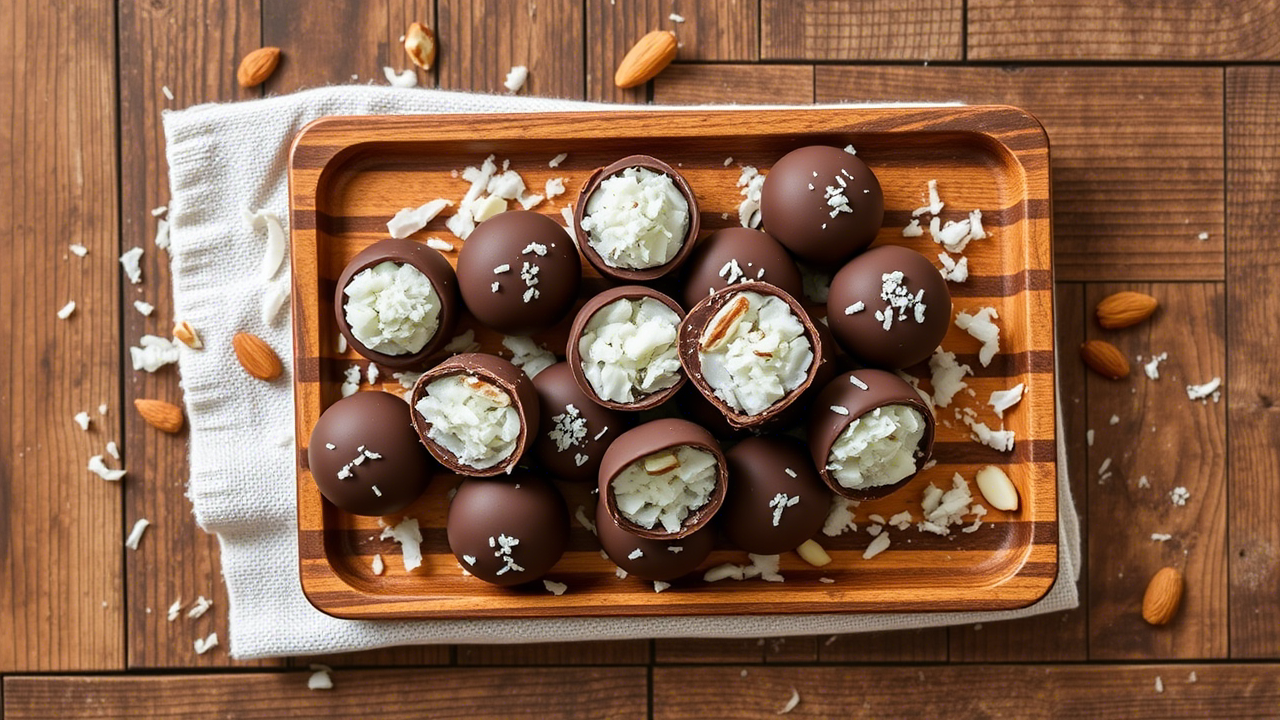These aren’t just little snack balls you pop into your mouth at 3 p.m. when you’re bored. Almond Joy Coconut Bites are a full-on textural experience that bring the decadent nostalgia of the classic candy bar into modern, health-forward kitchens. They’re not new—but they’re having a moment. And chefs, bakers, and nutrition-conscious pros alike are paying attention.
This article dives into the hows, whys, and subtle intricacies of Almond Joy Coconut Bites: how to get them right, what to avoid, how to scale them, and how this humble treat can flex from snack food to plated dessert in a blink.
Let’s not mess around.
The Anatomy of an Almond Joy Coconut Bite
At its core, an Almond Joy Coconut Bite has four key components. Each one’s simple. But simplicity’s a cruel trickster—it demands perfection.
- Shredded Coconut (unsweetened or sweetened—both have roles)
- Sweetener (condensed milk, maple syrup, dates—depends on your angle)
- Almonds (whole, roasted, slivered… again, depends)
- Chocolate Coating (milk, dark, or something fancy like 70% couverture)
It’s easy to think this is just “blend and roll,” but oh no. Balance is everything. Too much coconut, and you’re chewing beach towel. Too little binder, and it crumbles like a bad apology. That’s why pros fuss over ratios—and we’ll get to that.
The Ratio Game: Why It’s Trickier Than You Think
Get this: a standard Almond Joy bar has a 4:1 coconut to almond ratio (by volume). But when you’re making bite-sized versions, that scale breaks down. You need cohesion. Surface area plays a role. One almond can overpower or vanish entirely in a small ball.
Most pros settle on a base ratio of:
- 2 cups finely shredded coconut
- ½ cup sweetened condensed milk
- 1 teaspoon vanilla extract
- 16 whole almonds
- 150g tempered chocolate
But here’s the thing—humidity screws this up. Your coconut might be dry as chalk or already halfway to paste. Adjust your binder accordingly. You want it tacky, not wet.
Don’t eyeball it. Use a digital scale. Your tongue will thank you.
Sweetener Choices: Healthier Isn’t Always Better
Let’s talk alternatives. Maple syrup, agave, honey, or date paste can replace the condensed milk. But it’s not a 1:1 swap.
For example:
- Maple syrup adds flavor but thins the mixture. You’ll need extra coconut.
- Date paste offers fiber, but the texture’s dense. Expect a fudgier bite.
I once tried molasses. Never again. Tasted like a coconut fell into a barbecue pit.
The real trick? Test batches. Small scale. Let them sit for 24 hours, chilled. Texture always changes overnight.
Coconut: It’s More Than Just Flakes
Most recipes call for sweetened shredded coconut. But try this—blend half of it into a coarse meal. Why? Better binding. The mix holds tighter. You get a smoother bite. No rogue strings in your teeth.
Also: Toast some of it. Even lightly. Adds depth. Think browned butter vibes, but coconut-style. Pros love this for layering flavor without extra ingredients.
Just don’t burn it. One minute too long and it’s charcoal with a tan.

Almonds: Roasted, Raw, or No?
There’s a war in pro kitchens over this.
Camp A: Use roasted almonds. Better crunch. Nutty flavor pops through the sweetness.
Camp B: Raw almonds. They soften slightly in the fridge, creating contrast.
Camp C: No almond inside at all. Instead, grind ’em into the coconut mix.
Each version has merit. But be honest—biting into a whole roasted almond in the center? That’s the classic Joy. The crunch sells it. My vote’s with Camp A.
Chocolate: Where Everything Falls Apart or Comes Together
Don’t use cheap baking chips.
Let me say that again. Don’t use cheap chocolate chips.
They’ve got stabilizers. Waxy mouthfeel. They won’t temper properly. They dull. They bloom. They crack. They disrespect your work.
Use couverture. Or at the very least, a good-quality dark or milk chocolate bar with cocoa butter listed in the first three ingredients. Temper it. Yes, temper it. Even for bites. Especially for bites.
If you don’t know how to temper, here’s the dirty-cheat way:
- Melt ¾ of your chocolate slowly in a double boiler to 115°F (for dark) or 110°F (for milk).
- Remove from heat.
- Stir in remaining chopped chocolate.
- Keep stirring until it drops to 88–90°F.
- Use immediately.
It won’t win you a chocolatier medal, but your bites won’t bloom.
Scaling for a Professional Kitchen
For chefs doing volume, hand-rolling 100+ bites is a nightmare. Use a small cookie scoop (size 60 is sweet-spot). Line a sheet tray with parchment. Freeze for 15 minutes before dipping.
Dipping tip: Use a fork. Not a toothpick. Not your fingers. A fork.
Let excess chocolate drip off. Tap gently. Don’t smother the bite in thick chocolate—it overwhelms the texture.
You want thin coating. Snap and give. Not armor plating.
Flavor Variations Worth Their Salt
You can riff, sure. But don’t go crazy. Almond Joy Bites live in the simple zone. Still, here are a few pro-level twists:
- Sea salt flake finish: Just a whisper of crunch and salinity.
- Espresso powder in the chocolate: Tiny punch of bitterness to cut sweetness.
- Orange zest in the coconut base: Surprisingly fresh. Pairs well with dark chocolate.
- Swap almonds for hazelnuts: Think Nutella meets tropical vacation.
Test before committing to a flavor change. Some pairings work better on paper than on palate.
Shelf Life and Storage: It’s Not Forever
Refrigerated, these last about 10–14 days. But only if kept sealed.
Chocolate starts to take on odors. Coconut goes stale if exposed to air. Almonds get soft.
For best results:
- Store in airtight container.
- Place parchment between layers.
- Avoid freezing unless absolutely necessary. Chocolate cracks. Texture suffers.
One caveat—if you used date paste or maple syrup? Shelf life shortens. Use within 5–7 days.
Nutrition & Misconceptions
Here’s a stat: a standard Almond Joy candy bar has 220 calories and 21g sugar. A homemade bite using sweetened coconut and condensed milk? Clocks in around 110 calories, 8–10g sugar.
Using dates or maple? Slightly more fiber, slightly less refined sugar—but it’s still dessert.
So no, these aren’t “healthy” snacks in the kale-chia-spirulina way. But they’re better-for-you alternatives to gas station candy.
Marketing tip for pros: Position them as mindful indulgence, not health food.

Emerging Trend: Functional Versions
Some chefs are now boosting these with adaptogens or protein powders.
- Ashwagandha or maca for stress support.
- Pea protein or collagen for workout recovery.
- Even CBD oil in the coconut base (if legally permitted).
It’s a niche crowd, but growing. If you’re in a wellness café, spa, or urban bakery? Worth exploring. But dose properly. Label clearly. And taste test like mad—some of those powders are bitter as heck.
Plating Almond Joy Bites for Service
Yes, they’re humble. But they plate beautifully.
- Stack three in a pyramid on a slate tile.
- Drizzle a chocolate spiral.
- Add a single edible flower or a few toasted coconut shards.
Suddenly, you’ve got a $12 plated dessert at a midscale bistro.
Chef’s secret: warm the plate slightly. Not hot—just warm. Helps contrast the chilled bite. Mouthfeel becomes a journey.
Why Almond Joy Coconut Bites Aren’t Going Anywhere
It’s nostalgia. It’s texture. It’s the weird sense of comfort that coconut, almond, and chocolate bring when they’re all working together like a trio of slightly dysfunctional best friends.
The professional appeal? Minimal ingredients, scalable prep, high yield, and customizable presentation. You can batch these before service, use them in dessert flights, gift boxes, catering trays. They freeze (carefully), ship (carefully), and sell.
They’re what we call a “sticky menu item.” Once people try them, they ask about them again. That’s ROI gold.
Final Takeaways and Pro Tips
- Always weigh your ingredients. Cups are for civilians.
- Don’t skip the chill. Bites fall apart when warm.
- Use real chocolate. Life’s too short for fake wax.
- Test for texture. Tacky mix is good. Wet is not.
- Know your crowd. Make health tweaks only if flavor wins.
Almond Joy Coconut Bites may look simple—but they demand respect. Whether you’re in a high-volume kitchen or running a cottage bakery, they deliver on taste, texture, and emotion. And that’s the holy trinity of food, ain’t it?
Now go make some magic.
FAQs
What are Almond Joy Coconut Bites?
They’re small, no-bake treats made with shredded coconut, almonds, and chocolate—like a homemade version of the classic candy bar.
Can I make them without sweetened condensed milk?
Yes, you can use maple syrup, honey, or date paste, but you’ll need to adjust the coconut ratio.
Are Almond Joy Coconut Bites healthy?
They’re a better alternative to store-bought candy, but they’re still a sweet treat—not a health food.
What type of chocolate works best?
Use high-quality dark or milk chocolate with real cocoa butter; avoid baking chips.
Can I freeze Almond Joy Coconut Bites?
You can, but freezing may cause chocolate to crack and alter texture.
How long do they last in the fridge?
Stored properly in an airtight container, they last 10 to 14 days.
Do I need to roast the almonds first?
Roasting boosts crunch and flavor, but raw almonds work too if you prefer a softer bite.
Can I use desiccated coconut instead of shredded?
Yes, but you may need extra binder, as desiccated coconut is drier.
How do I keep them from falling apart?
Chill the mixture before shaping and ensure the mix is tacky, not wet.
Can I add protein powder or adaptogens?
Yes, many pros do—just make sure flavor and texture still hold up.

Mariana is a passionate home cook who creates delicious, easy-to-follow recipes for busy people. From energizing breakfasts to satisfying dinners and indulgent desserts, her dishes are designed to fuel both your body and hustle.
When she’s not in the kitchen, she’s exploring new flavors and dreaming up her next recipe to share with the Foodie Hustle community.

